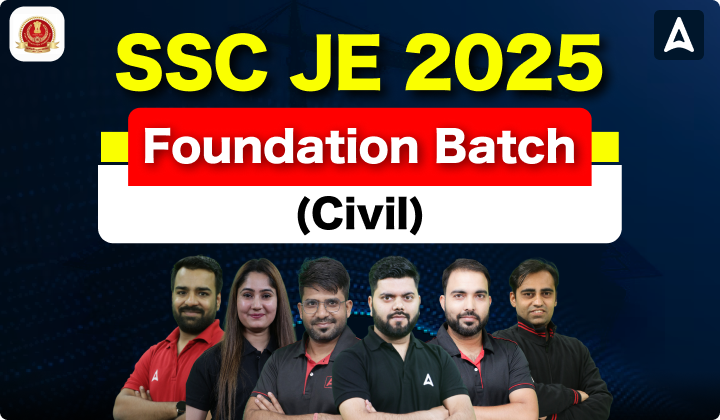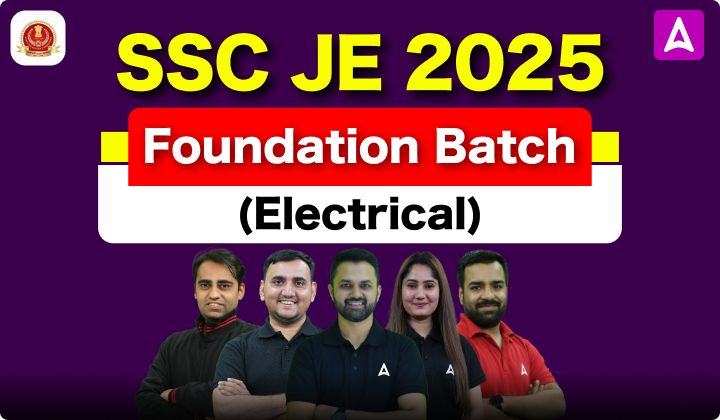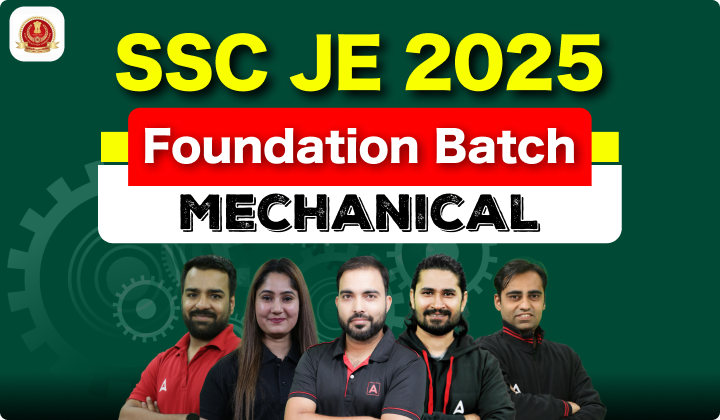Table of Contents
If you’re an engineering graduate aiming for a government job, the SSC JE Exam 2025 is a great opportunity. The exam will be held from 27th to 31st October 2025. This article provides essential information about the SSC JE Syllabus 2025 and the updated exam pattern. Familiarizing yourself with the syllabus, exam pattern, and key dates will help improve your preparation and increase your chances of success. Candidates can download detailed syllabus information for each engineering stream – Civil, Electrical, and Mechanical – to focus their preparation effectively.
SSC JE Syllabus 2025
The SSC JE Syllabus 2025 is divided into two papers: Paper 1 (Objective) and Paper 2 (Descriptive), designed to assess both general aptitude and core technical knowledge. Paper 1 includes three sections — General Intelligence & Reasoning, General Awareness, and General Engineering (Civil, Electrical, or Mechanical, as per the candidate’s discipline). Topics range from reasoning and current affairs to fundamental engineering subjects like building materials, circuits, thermodynamics, and more. Paper 2 focuses entirely on the chosen engineering stream and evaluates in-depth technical understanding through a descriptive format. A clear grasp of the syllabus helps candidates plan their preparation effectively and improves their chances of success in the exam.
SSC Junior Engineer Syllabus 2025 Overview
The SSC JE Notification 2025 has been out candidates who are going to apply can check the syllabus overview from the table below.
| SSC JE Syllabus 2025 | |
| Organization | Staff Selection Commission |
| Exam Name | SSC Junior Engineer (SSC JE) Exam 2025 |
| Application Starts | 30th June to 21st July 2025 |
| Name of Post | Junior Engineer |
| SSC JE Syllabus & SSC JE Exam Pattern | Available Here |
| Selection Process | Paper 1 & Paper 2 |
| Official Website | www.ssc.gov.in |
SSC JE Exam Pattern 2025
| Papers | Type of Examination | Subjects | Mode of examination |
| Paper 1 | Objective Multiple Choice | (i) General Intelligence and Reasoning
(ii) General Awareness (iii) Part-A General Engineering (Civil & Structural) or |
CBT (Online) |
| Paper 2 | Objective Multiple Choice | Part-A General Engineering (Civil & Structural) Part B: General Engineering (Electrical) Part-C General Engineering (Mechanical) |
CBT (Online) |
SSC JE Paper 1 Exam Pattern 2025
The SSC JE 2025 Paper 1 is the first stage of the selection process for the SSC Junior Engineer exam. This paper is very important for candidates who want to move forward in the recruitment process.
- It includes three sections: General Knowledge, General Awareness, and General Engineering (based on Civil, Electrical, or Mechanical branch). All the questions in this paper are multiple-choice (objective type).
- The total time given to complete the exam is 2 hours. To qualify for the next stage, candidates must pass Paper 1 by scoring the required marks.
- There is also negative marking; 0.25 marks will be deducted for every wrong answer.
| SSC JE 2025 Paper 1 Exam Pattern | |||
| Papers | No. Of Questions | Maximum Marks | Duration |
| General Intelligence & Reasoning | 50 | 50 | 2 Hrs. |
| General Awareness | 50 | 50 | |
| Part –A General Engineering (Civil & Structural) OR | 100 | 100 | |
| Part B: General Engineering (Electrical) OR | |||
| Part-C General Engineering (Mechanical) | |||
| Total | 200 | 200 | |
SSC JE Paper 2 Exam Pattern 2025
Candidates who pass the SSC JE 2025 Paper 1 cut-off will move on to take SSC JE Paper 2:
- The SSC JE Paper 2 is a computer-based test.
- Paper 2 will have questions only from the technical subject related to the candidate’s chosen educational qualification.
- SSC JE 2025 Paper 2 is worth a total of 300 marks.
- There is a negative marking of 1 mark for each incorrect answer in Paper 2 of the SSC JE 2025 exam.
| SSC JE 2025 Paper 2 Exam Pattern | |||
| Paper 2 | Questions | Marks | Time |
| Part-A General Engineering (Civil & Structural) | 100 | 300 | 2 Hrs. |
| OR | |||
| Part B: General Engineering (Electrical) | 100 | 300 | 2 Hrs. |
| OR | |||
| Part-C General Engineering (Mechanical) | 100 | 300 | 2 Hrs. |
SSC JE Paper 1 Syllabus 2025
The SSC JE Paper 1 Syllabus includes three main sections: General Intelligence & Reasoning, General Awareness, and General Engineering (Civil & Structural, Electrical, and Mechanical). The syllabus is divided into two components: General Intelligence & Reasoning, General Awareness, and General Engineering (Civil and Structural, Electrical & Mechanical). In the General Intelligence & Reasoning section, candidates can expect topics such as classification, analogy, coding-decoding, and more. The details of the SSC JE syllabus are given below:
| Section | Topics |
| General Intelligence & Reasoning |
|
| General Awareness |
|
| Mechanical Engineering |
|
| Electrical Engineering |
|
| Civil Engineering |
|
SSC JE Paper 2 Syllabus 2025
Civil Engineering Syllabus
The SSC JE Tier 2 exam for Civil Engineering includes several key topics, such as Building Materials, Estimating Costs, Surveying, Soil Mechanics, Hydraulics, Irrigation Engineering, Transportation Engineering, Environmental Engineering, Theory of Structures, Concrete Technology, RCC Design, and Steel Design. To excel in the Tier 2 exam, candidates must thoroughly understand these subjects.
- Building Materials: Physical and Chemical properties, classification, standard tests, use, and manufacture/quarrying of materials e.g. building stones, silicate-based materials, cement (Portland), asbestos products, timber, wood-based products, laminates, bituminous materials, paints, varnishes.
- Estimating, Costing, and Valuation: Estimate, glossary of technical terms, analysis of rates, methods, and units of measurement. Items of work – earthwork, brickwork (modular & traditional bricks), RCC work, shuttering, timber work, painting, flooring, plastering, boundary wall, brick building, water tank, septic tank, bar bending schedule, centre line method, mid-section formula, trapezoidal formula, Simpson’s rule. Cost estimate of septic tank, flexible pavements, tube well, isolated and combined footings, steel truss, piles, and pile caps. Valuation – value and cost, scrap value, salvage value, assessed value, sinking fund, depreciation and obsolescence, methods of valuation.
- Surveying: Principles of surveying, measurement of distance, chain surveying, prismatic compass, compass traversing, bearings, local attraction, plane table surveying, theodolite traversing, adjustment of theodolite, levelling, contouring, curvature and refraction corrections, temporary and permanent adjustments of dumpy level, methods of contouring, use of contour map, tachymetric survey, curve setting, earthwork calculation, advanced surveying equipment.
- Soil Mechanics: Origin of soil, phase diagram, definitions – void ratio, porosity, degree of saturation, water content, specific gravity of soil grains, unit weights, density index, grain size distribution curves, Atterberg’s limits, ISI soil classification, plasticity chart, permeability of soil, coefficient of permeability, unconfined and confined aquifers, effective stress, quicksand, consolidation of soils, principles of consolidation, pre-consolidation pressure, shear strength of soils, soil compaction, earth pressure theories, bearing capacity of soils.
- Hydraulics: Fluid properties, hydrostatics, measurements of flow, Bernoulli’s theorem and its application, flow through pipes, flow in open channels, weirs, flumes, spillways, pumps, and turbines.
- Irrigation Engineering: Definition, necessity, benefits, and effects of irrigation. Types and methods of irrigation. Hydrology – measurement of rainfall, runoff coefficient, rain gauge, water requirement of crops, duty, delta and base period, Kharif and Rabi crops, command area, crop ratio, overlap allowance, irrigation efficiencies. Types of canals, canal lining, shallow and deep wells, yield from a well, weirs, failure of weirs, flood control methods, water logging, land reclamation, major irrigation projects in India.
- Transportation Engineering: Highway engineering – cross-sectional elements, geometric design, types of pavements, pavement materials, design of flexible and rigid pavements, pavement maintenance, highway drainage. Railway engineering – components of the permanent way, track geometry, points and crossings, traffic engineering – traffic surveys, intersections, interchanges, traffic signals, road safety.
- Environmental Engineering: Quality of water, sources of water supply, purification, distribution, sanitation, sewerage systems, sewage treatments. Solid waste management, air pollution, noise pollution – causes, effects, and control.
- Theory of Structures: Elasticity constants, types of beams – determinate and indeterminate, bending moment and shear force diagrams for beams, moment of inertia, shear stress for tee, channel, and compound sections, eccentric loads, slope deflection, critical load, columns, torsion of circular sections.
- Concrete Technology: Properties, advantages, and uses of concrete, cement aggregates, water-cement ratio, workability, mix design, storage, batching, mixing, placement, compaction, finishing, curing, quality control, hot weather and cold weather concreting, repair, and maintenance of concrete structures.
- RCC Design: RCC beams – flexural strength, shear strength, bond strength, design of singly reinforced and double reinforced beams, cantilever beams, T-beams, lintels, one-way and two-way slabs, isolated footings, reinforced brickworks, columns, staircases, retaining walls, and water tanks (RCC design may be based on both limit state and working stress methods).
- Steel Design: Steel design and construction of steel columns, beams, roof trusses plate girders.
SSC JE Previous Year Question Papers
Electrical Engineering Syllabus
The SSC Junior Engineer Syllabus 2025 for Electrical Engineering is given below:
- Basic concepts: Resistance, inductance, capacitance, and various factors affecting them. Concepts of current, voltage, power, energy, and their units.
- Circuit law: Kirchhoff’s law, Simple Circuit solution using network theorems.
- Magnetic Circuit: Concepts of flux, MMF, reluctance, Different kinds of magnetic materials, Magnetic calculations for conductors of different configurations e.g. straight, circular, solenoidal, etc. Electromagnetic induction, self, and mutual induction.
- AC Fundamentals: Instantaneous, peak, R.M.S., and average values of alternating waves, Representation of sinusoidal wave form, simple series and parallel AC Circuits consisting of R.L. and C, Resonance, Tank Circuit. Poly Phase system – star and delta connection, 3-phase power, DC, and sinusoidal response of R-L and R-C circuit.
- Measurement and measuring instruments: Measurement of power (1 phase and 3 phase, both active and reactive) and energy, the 2-wattmeter method of 3-phase power measurement. Measurement of frequency and phase angle. Ammeter and voltmeter (both moving oil and moving iron type), an extension of range wattmeter, Multimeters, Megger, Energy meter, AC Bridges. Use of CRO, Signal Generator, CT, PT, and their uses. Earth Fault detection.
- Electrical Machines: (a) D.C. Machine – Construction, Basic Principles of D.C. motors and generators, their characteristics, speed control, and starting of D.C. Motors. Method of braking motor, Losses, and efficiency of D.C. Machines. (b) 1-phase and 3-phase transformers – Construction, Principles of operation, equivalent circuit, voltage regulation, O.C., and S.C. Tests, Losses, and efficiency. Effect of voltage, frequency, and waveform on losses. Parallel operation of 1-phase/3 3-phase transformers. Auto transformers. (c) 3-phase induction motors, rotating magnetic field, the principle of operation, equivalent circuit, torque-speed characteristics, starting and speed control of 3-phase induction motors. Methods of braking, the effect of voltage and frequency variation on torque speed characteristics.
- Fractional Kilowatt Motors and Single Phase Induction Motors: Characteristics and Applications.
- Synchronous Machines: Generation of 3-phase E.M.F. armature reaction, voltage regulation, parallel operation of two alternators, synchronizing, and control of active and reactive power. Starting and applications of synchronous motors.
- Generation, Transmission, and Distribution: Different types of power stations, Load factor, diversity factor, demand factor, cost of generation, and interconnection of power stations. Power factor improvement, various types of tariffs, types of faults, and short circuit current for symmetrical faults. Switchgears – rating of circuit breakers, Principles of arc extinction by oil and air, H.R.C. Fuses, Protection against earth leakage / over current, etc. Buchholtz relay, Merz-Price system of protection of generators & transformers, protection of feeders and bus bars. Lightning arresters, various transmission and distribution systems, comparison of conductor materials, and the efficiency of different systems. Cable – Different types of cables, cable ratings, and derating factors.
- Estimation and costing: Estimation of lighting scheme, electric installation of machines, and relevant IE rules. Earthing practices and IE Rules.
- Utilization of Electrical Energy: Illumination, Electric heating, Electric welding, Electroplating, Electric drives, and motors.
- Basic Electronics: Working of various electronic devices e.g. P N Junction diodes, Transistors (NPN and PNP type), BJT, and JFET. Simple circuits using these devices.
Life of a Junior Engineer After Clearing SSC JE
Mechanical Engineering Branch Syllabus
The SSC JE Syllabus 2025 for Mechanical Engineering is given below:
- Theory of Machines and Machine Design: Concept of a simple machine, Four bar linkage and link motion, Flywheels and fluctuation of energy, Power transmission by belts – V-belts and Flat belts, Clutches – Plate and Conical clutch, Gears – Type of gears, gear profile and gear ratio calculation, Governors – Principles and classification, Riveted joint, Cams, Bearings, Friction in collars and pivots.
- Engineering Mechanics and Strength of Materials: Equilibrium of Forces, Law of motion, Friction, Concepts of stress and strain, Elastic limit and elastic constants, Bending moments and shear force diagram, Stress in composite bars, Torsion of circular shafts, Bucking of columns – Euler’s and Rankin’s theories, Thin walled pressure vessels.
- Properties of Pure Substances: p-v & P-T diagrams of pure substances like H2O, Introduction of steam table for steam generation process; definition of saturation, wet & superheated status. Definition of dryness fraction of steam, degree of superheat of steam. H-s chart of steam (Mollier’s Chart).
- 1st Law of Thermodynamics: Definition of stored energy & internal energy, 1st Law of Thermodynamics of cyclic process, Non-Flow Energy Equation, Flow Energy & Definition of Enthalpy, Conditions for Steady State Steady Flow; Steady State Steady Flow Energy Equation.
- 2nd Law of Thermodynamics: Definition of Sink, Source Reservoir of Heat, Heat Engine, Heat Pump & Refrigerator; Thermal Efficiency of Heat Engines & co-efficient of performance of Refrigerators, Kelvin – Planck & Clausius Statements of 2nd Law of Thermodynamics, Absolute or Thermodynamic Scale of temperature, Clausius Integral, Entropy, Entropy change calculation of ideal gas processes. Carnot Cycle & Carnot Efficiency, PMM-2; definition & its impossibility.
- Air standard Cycles for IC engines: Otto cycle; plot on P-V, T-S Planes; Thermal Efficiency, Diesel Cycle; Plot on P-V, T-S planes; Thermal efficiency. IC Engine Performance, IC Engine Combustion, IC Engine Cooling & Lubrication.
- Rankine cycle of steam: Simple Rankine cycle plot on P-V, T-S, h-s planes, Rankine cycle efficiency with & without pump work.
- Boilers; Classification; Specification; Fittings & Accessories: Fire Tube & Water Tube Boilers.
- Air Compressors & their cycles: Refrigeration cycles; Principle of a Refrigeration Plant; Nozzles & Steam Turbines
- Properties & Classification of Fluid: ideal & real fluids, Newton’s law of viscosity, Newtonian and Non-Newtonian fluids, compressible and incompressible fluids.
- Fluid Statics: Pressure at a point.
- Measurement of Fluid Pressure: Manometers, U-tube, and Inclined tube.
- Fluid Kinematics: Streamline, laminar & turbulent flow, external & internal flow, continuity equation.
- Dynamics of ideal fluids: Bernoulli’s equation, Total head, Velocity head, Pressure head; Application of Bernoulli’s equation.
- Measurement of Flow Rate: Venturi Meter, Pilot tube, Orifice Meter. Hydraulic Turbines: Classifications, Principles.
- Centrifugal Pumps: Classifications, Principles, Performance. Production Engineering
- Classification of Steels: mild steel & alloy steel, Heat treatment of steel, Welding – Arc Welding, Gas Welding, Resistance Welding, Special Welding Techniques i.e. TIG, MIG, etc. (Brazing & Soldering), Welding Defects & Testing; NDT, Foundry & Casting – methods, defects, different casting processes, Forging, Extrusion, etc, Metal cutting principles, cutting tools, Basic Principles of machining with (i) Lathe (ii) Milling (iii) Drilling (iv) Shaping (v) Grinding, Machines, tools & manufacturing processes.
SSC JE Syllabus 2025 PDF
The Staff Selection Commission (SSC) will soon announce the SSC JE Exam 2025 on its official website. This exam presents a key opportunity for engineering candidates seeking positions in government departments. Aspiring candidates should align their study strategies with the official SSC JE Syllabus PDF, available on the SSC website. To improve preparation, candidates are advised to use resources like previous years’ question papers and mock tests to familiarize themselves with the exam format and identify strengths and weaknesses. Thorough preparation based on the official syllabus is crucial for success in the SSC JE Examination.
SSC JE Syllabus 2025- Click Here to Download PDF
How to Use the SSC JE Syllabus for Preparation?
The SSC JE syllabus is a crucial roadmap for your exam preparation. By using it strategically, you can focus your efforts on the most important topics and maximize your score. SSC JE syllabus covers General Intelligence & Reasoning, General Awareness, and General Engineering (Civil & Structural, Electrical, and Mechanical) for Paper 1. Paper 2 is specific to the chosen engineering discipline.
- Understand the Exam Pattern First: Before diving into the syllabus, get familiar with the SSC JE exam pattern to understand the structure and weightage of each section.
- Break the Syllabus into Sections: Divide the syllabus into Paper 1 (General Intelligence, General Awareness, General Engineering) and Paper 2 (core engineering subject).
- Prioritize High-Weightage Topics: Identify and focus on topics that carry more marks or are frequently repeated in previous years’ exams.
- Create a Study Plan: Use the syllabus to build a realistic and consistent study schedule, covering all topics in a time-bound manner.
- Track Your Progress: Regularly mark completed topics and revisit challenging ones to ensure full syllabus coverage.
- Practice with Syllabus-Based Questions: Solve topic-wise previous year papers and mock tests that directly relate to the syllabus.

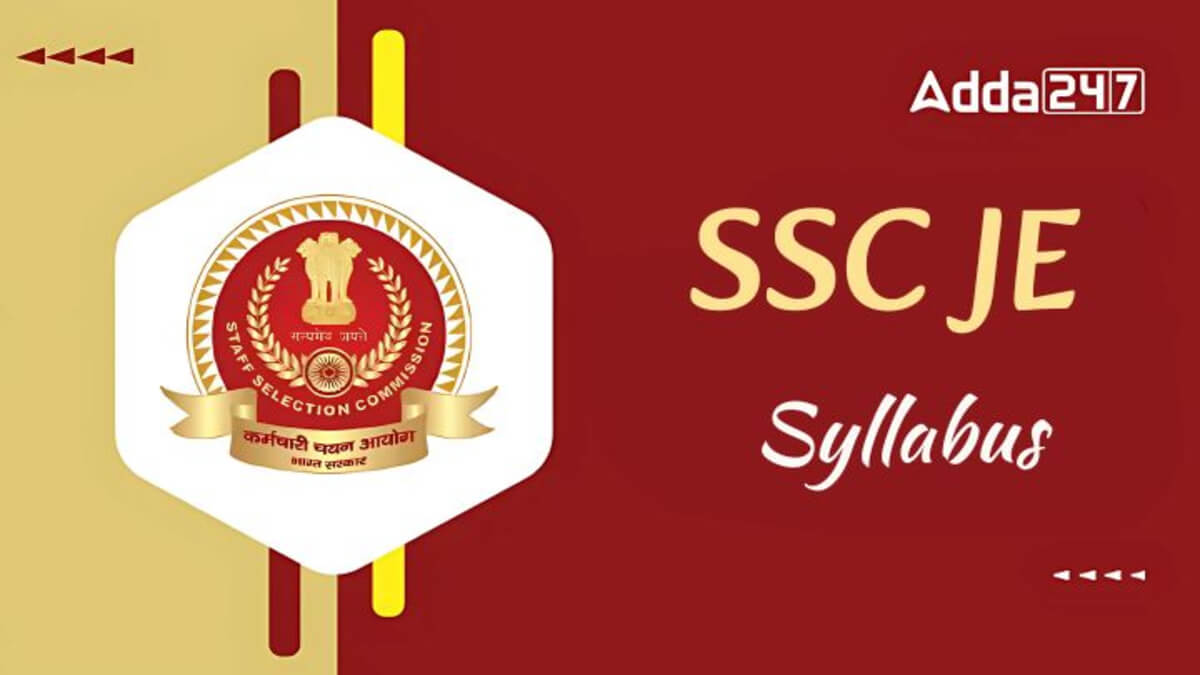
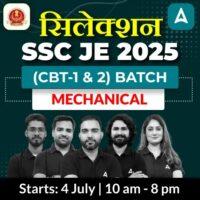
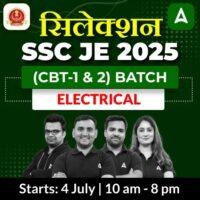
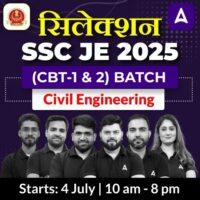

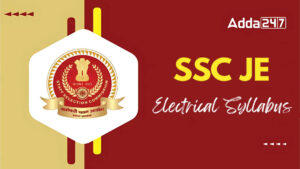 SSC JE Electrical Syllabus 2025 For Pape...
SSC JE Electrical Syllabus 2025 For Pape...
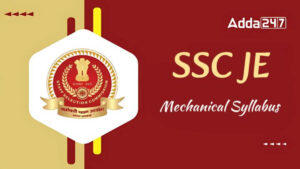 SSC JE Mechanical Syllabus 2025, Subject...
SSC JE Mechanical Syllabus 2025, Subject...
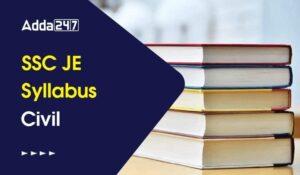 SSC JE Civil Syllabus 2025, Check Comple...
SSC JE Civil Syllabus 2025, Check Comple...
